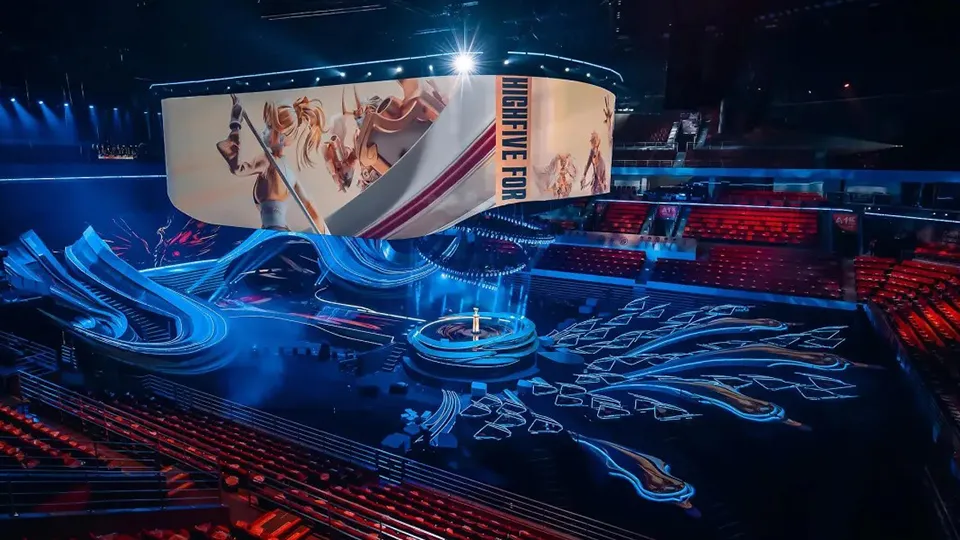
LED displays used in Esports
Introduction
From traditional sports to new sports events, esports has emerged as a prime example of the fusion of technology and sportsmanship. The evolution from the birth of professional esports events to becoming an official Asian Games event, and now the establishment of the International Olympic Committee’s Esports Committee, highlights the rapid growth of esports. This development not only symbolizes the integration of technology and the gaming industry, but also rekindles public interest in this new form of entertainment. More importantly, insights from the forefront of esports have significantly accelerated the demand for esports LED displays in stadiums, gaming shows, monitors, and other related equipment.

The Global Impact of Esports
On July 12, the International Olympic Committee (IOC) announced its partnership with the Saudi Arabian Olympic Committee to host the first Olympic Esports Games in Saudi Arabia in 2025. This proposal is scheduled for consideration at the upcoming 142nd IOC session in Paris. Before the idea of “Esports in the Olympics” gained traction, the inclusion of esports in the Asian Games had already attracted considerable attention. Last year’s Asian Games in Hangzhou saw esports make its debut as an official competition event.
Beyond the Asian Games, the 2024 Esports World Cup officially kicked off in Riyadh, Saudi Arabia’s capital. The event, which ran from July 3 to August 25, featured 22 competitions across 21 esports titles, with 1,500 athletes from 425 clubs vying for the honor of being crowned the first Esports World Cup champion. In addition to professional matches, this year’s Esports World Cup also hosted the largest esports festival ever, offering attendees the opportunity to participate in gaming exhibitions, amateur competitions, and concerts.

The Crucial Role of LED Screens in Esports Arenas
As offline esports events continue to increase, the demand for esports arenas has become more apparent. In the construction of these arenas, LED screens for esports events are indispensable. The China Sports Venues Association has established clear guidelines on the location, functional zoning, and hardware systems for esports venues. The standards explicitly require that esports arenas of Class C or higher must be equipped with esports LED displays. In the spectator area, at least one main LED screen must be installed, along with several auxiliary LED screens, to ensure that spectators can clearly watch the matches under normal conditions. In addition, the standard requires the use of LED screens with a pixel pitch of P3 or higher.
Unlike traditional sports events, esports demands higher screen quantity and quality, with large screens being a significant advantage of LED displays. The seamless splicing characteristic of LED screens provides viewers with an unparalleled viewing experience, making them the preferred choice for esports arena screens.

LED Displays in Esports: The Path to Innovation
In the esports market, with the rapid development of the industry, game content, and CPU/GPU performance upgrades, the demand for esports monitors remains strong. Gaming enthusiasts are constantly looking for monitors with higher refresh rates, lower latency, and superior image quality to enhance their gaming experience and competitive level.
Recent advances in Mini/Micro LED display technology have made the entry of LED display products into the esports screen market a reality. Compared to OLED screens, Mini LED backlight technology can deliver equally detailed images, with better cost-effectiveness and longevity. Mini LED displays feature higher chip count and density, resulting in brighter and more vivid images with finer details. The high pixel density and small unit size of the light source can achieve higher brightness and a more controllable color gamut.
In addition, Mini LED technology holds great potential for iterating existing display technologies. The evolution of LED display technology follows a basic principle: picture quality (resolution, color, response speed, contrast, etc.) and form (thinness, flexibility, etc.) determine the feasibility of technology replacement, while cost determines the penetration rate of this replacement. This iterative feature reflects the huge market potential of Mini LED displays. Recognizing the huge commercial value of esports LED displays, many display companies have already started investing in the Mini/Micro LED market. In the future, Mini LED is expected to gradually capture a larger share of the esports market as technology advances.

Expanding China’s Influence in the Global Esports Market
As a market that overlaps technology, entertainment, and sports industries, esports offers tremendous opportunities across a variety of industries. LED displays, as a versatile product, hold significant advantages in this cross-cutting market: a wide variety of products, strong adaptability, and the ability to customize products for specific applications. Currently, most LED display applications are concentrated in esports arenas. These include outdoor broadcasting of esports events, advertising sponsorships, esports-themed entertainment venues, esports stage performances, and other related thematic applications, all of which involve the use of LED displays.

Conclusion